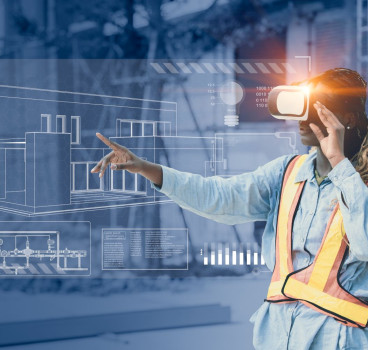Why are we taking so long to adopt new tech in construction
The global construction industry stands at a crossroads. While some forward-thinking firms have embraced digital transformation, a significant portion of the sector remains stuck in outdated practices. For every company investing in AI-driven project management, robotics, and digital modelling, there are many still hesitant to change, writes John Ridgeway.
Despite the clear advantages of technology in boosting productivity, safety and profitability, adoption across the industry has been slow and uneven. While the leading players are setting examples, the broader construction sector must accelerate its move toward modern, tech-enabled solutions. The time for hesitation is over - the industry must commit to serious investment in digital transformation – and the time is now.
In recent years, we have seen impressive innovations in construction technology. Firms using Building Information Modelling (BIM), drones, wearable safety tech and automation are already reaping the benefits with improved efficiency, fewer accidents and better margins. These companies recognise that digital adoption is not a luxury - it's essential for survival in a competitive industry.
But on the other end of the spectrum, many firms still resist change. Smaller contractors, traditional firms and businesses operating with legacy systems often delay investment in technology due to concerns about cost, complexity and workforce readiness. The industry as a whole must acknowledge this disparity and push for faster, more widespread adoption.
The construction sector has been operating under the illusion that sticking to "tried-and-true" methods is a safe bet. In reality, its resistance to full-scale modernisation has led to severe consequences.
Companies that have adopted digital tools are seeing gains in efficiency, but industry-wide productivity remains low compared to other sectors. Studies show that construction productivity has grown at a slow rate, largely due to outdated processes and poor workflow optimisation. Workers on-site still spend significant time searching for materials, waiting for approvals and manually documenting data - tasks that could be streamlined with real-time communication tools, AI-assisted planning and predictive analytics.
Safety Concerns
Companies investing in wearable safety tech, AI-driven monitoring and automation are creating safer work environments. However, construction remains one of the most dangerous industries and the companies lagging behind in safety technology put workers at unnecessary risk. Every firm should be using innovations like smart helmets, sensor-based hazard detection and predictive analytics to prevent accidents before they happen.
Manual processes, fragmented communication and reliance on legacy systems still lead to project delays and financial losses. While some firms have integrated BIM, automated reporting and digital reporting, others continue using outdated tracking methods. Widespread adoption of digital project management could reduce waste, streamline decision-making, and protect margins. The result - even as technology reshapes industries, construction remains one of the slowest to modernise – and here is the most common excuse -“We’ve always done it this way.”
Legacy practices often feel safe, but they prevent real innovation. While some firms are embracing digital solutions, others still rely on paper-based workflows, inefficient scheduling and outdated communication methods. These companies risk falling behind as their more agile competitors gain market advantage.
Although initial investments in digital tools can be high, forward-thinking firms recognise that long-term savings outweigh upfront costs. Automated systems reduce material waste, minimise costly errors and increase efficiency, ultimately protecting profit margins.

Another and one of the most outdated excuses are that employees will resist digital tools. In reality, frontline workers benefit the most - tech simplifies on-site reporting, enhances safety and streamlines communication. Companies that invest in workforce training see smoother adoption and higher employee satisfaction.
Many companies also cite complexity as a barrier, yet modern technology is designed for seamless integration. Cloud-based platforms, mobile-friendly apps and AI-enhanced workflows make adoption easier than ever. The real challenge isn’t complexity - it’s mindset.
Why digital transformation cannot wait
The construction sector is at a tipping point. If companies fail to adopt technology now, they will lose their competitive edge – and here’s why. Drones, robotics and AI-driven analytics can automate repetitive tasks, freeing up skilled labour for higher-value activities. Digital project management tools enhance collaboration, reducing inefficiencies.
Wearable devices, real-time monitoring and predictive analytics can detect hazards before they become crises. Smart helmets and automated reporting systems help protect workers on-site. And probably most important of all - margins in construction are notoriously thin, but technology can change that. AI-powered budgeting, supply chain optimisation and automated billing ensure better financial control and higher returns on investment.
Even as individual companies modernise, partial adoption is not enough to drive a real industry-wide shift. For construction as a whole to remain competitive, all firms must invest in technology - not just the most forward-thinking ones. Companies that continue resisting digital adoption, risk being left behind as competitors embrace more efficient workflows and optimised processes.
The time for excuses is over. Construction firms must take responsibility and lead the charge toward digital transformation. The transition will not be effortless, but it will be necessary. Technology is not just a luxury - it’s a necessity for survival in a competitive industry. Those who fail to adapt will inevitably fall behind.
The global construction industry has spent too long making excuses for delaying digital transformation. But in an era of rapid technological advancement, inaction is the most dangerous choice of all. Tech adoption is not just about efficiency - it’s about safety, profitability and industry-wide evolution. No more delays. No more resistance. No more excuses. The time to transform is now.
Additional Blogs

Are architects losing their influence in the digital era?
For decades, architects have been the central creative force in construction, shaping the buildings we see and the way projects are conceived, communicated and delivered. Their role has been...
Read moreWhy the word “Innovation” has lost its meaning in construction
“Innovation” has become one of the most overused terms in construction. It appears in the dozens of press releases we receive each day, conference talks and project reports, often without any real...
Read more

Retrofit fatigue and are we asking too much of old buildings?
As the world pushes toward net-zero emissions, the pressure to decarbonise our built environment is more intense than ever. Governments, developers and building owners are investing heavily in energy...
Read more